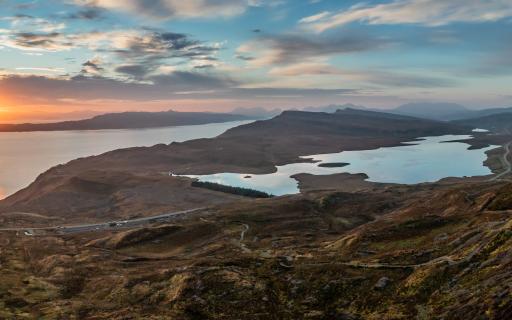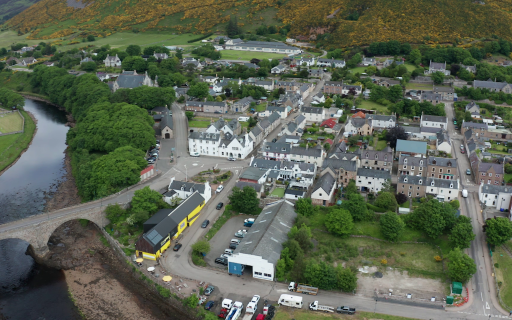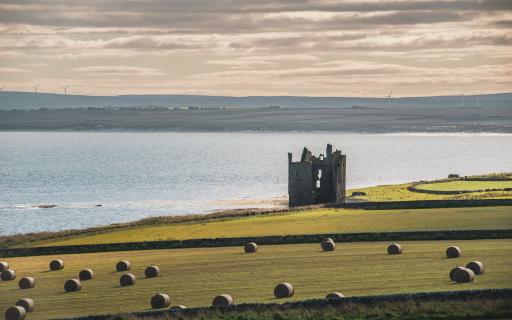
The Flow Country
The Sutherland Stitchers came together from Dornoch, Brora and Golpsie to stitch the story of the stories of the natural and cultural heritage of Sutherland and our cultural connections to the Flow Country.
This is their story.
In their panel, the Sutherland Stitchers have provided a beautiful homage to the natural and cultural heritage of the Flows. But just what is the history of this incredible landscape?
At 1,500 square miles, the Flow Country is the largest area of blanket bog in the world and a true wilderness. But not of the conventional sort.
To an untrained eye, it looks like a series of wide areas of flat moorland punctuated by thousands of dark pools and hundreds of lochans rather than a wild, impenetrable jungle untamed by man. But it is in fact a fascinating place, somewhere that comes into sharper and sharper focus the closer an observer looks.
It's also ancient. The blanket that covers the bog is deep, 10 metre layers of peat that have been forming for 11,000 years since the end of the last Ice Age. The flora is magnificent - tiny, but mighty - and the expanse of the Flow Country supports a vast range of bio-diverse habitats and wildlife. Rather than the tall redwoods of California or the lush interiors of tropical forests, the plants of the Flow Country are wet, subtly and beautifully coloured and vital to the health of the bog, and the planet.
 The Flow Country panel
The Flow Country panelImage provided by The Tapestry of the Highlands and Islands
THE FLOW
Its huge deposits of peat lock up an enormous amount of carbon that would otherwise be released into the atmosphere as damaging greenhouse gases. The blanket bog stores 3 times more carbon than all of Britain’s woodlands. The peatlands of the Flow Country alone trap around an incredible 400 million tonnes of carbon.
5,000 years ago as the huge Highland skies began to grow darker and the climate became colder and wetter, peat bogs began to form. Partially decayed vegetation, peat formation is the first stage of the millions-of-years-long process of creating coal. But it can be burned as fuel. Each spring, usually after the lambing, crofters go to the moor with a toirsgian, literally a peat-knife, a specially adapted, long-bladed spade. Once pieces the size of builders’ bricks are lifted out of the peat-bank (deeper and blacker pieces burn the hottest), they are stacked so that the winds off the ocean can dry them. Picking up and transporting peats back to stacks outside houses has to be a cooperative business. A family of four may need as many as 15,000 to last the year.
The reek, the smoke, is unique, distinctive, and it can be tasted in one of the most famous products to be made in the Highlands and Islands. The barley used to distill malt whisky on Islay is dried over peat fires and the reek imparts an unmistakable flavour.
We all found it a great experience of a group getting together and making decisions on how to work on the panel, who would like to stitch an area and what stitches and colours would be used.
- Jill Barnes
The interest in working together in this panel grew gradually and became a very democratic process with all contributing in their own way.
- Sue Gardiner
The Sutherland Stitchers not only brought their peat worker to life with magnificent colour and texture, they also included stories personal to them of local wildlife, historic sites and family.
Read these stories below and discover what is so special about the community in this part of the Highlands.
 The Sutherland Stitchers at the handover of their finished panel.
The Sutherland Stitchers at the handover of their finished panel.Image provided by The Sutherland Stitchers
Learn about the unique textiles used in the panel with the Sutherland Stitchers
WITH THANKS TO THE SUTHERLAND STITCHERS
This panel was stitched by Jill, Sue, Anne, Anne Ch, Barbara, Debra, Linda, Mairi, Sally and Anne F who gave their time, skill and energy to completing a fantastic artwork for their area.
If you would like to see the panel up close and admire the detail of their work, you can currently view the panel in the Inverness Castle Experience.
EXPLORE MORE STITCHERS STORIES BELOW
Swipe left for more







